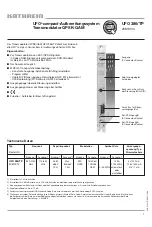
Testing, testing, 1, 2, 3...
Apply power to the unit making sure you are applying the power correctly. Check that no
device is running hot. Any sign of smoke or strange smells turn off the power immediately and
recheck the polarity of the power supply, and the direction of the ICs in their sockets.
Assuming everything is OK so far, it is time to apply an audio input. Use a signal like a
triangle output from a VCO. Middle A, 440Hz is a good note to use. Turn down all the pots
to their minimum setting and insert your triangle wave signal into IN X (AC). Listen to the
output signal from the ring modulator module. For the moment you should hear nothing.
Turn up the X LEVEL pot to full. Again, you shouldn't hear anything, but maybe you will
hear a little triangle wave bleedthrough. Now slowly turn up the Y OFFSET pot. If all is well
this should behave like a volume control, increasing the level of the triangle wave as it is
turned up.
Ensure that altering Y LEVEL should have no effect on the sound, but that X LEVEL
behaves also like a volume control. It should seem that both X LEVEL and Y OFFSET do the
same thing. They do not of course, since X LEVEL is altering the signal level going into the
ring modulator circuit, and Y OFFSET is adjusting the gain of the amplification within the ring
modulator.
Swap the input signal over to the IN X (DC) input. This should have no apparent effect on the
sound.
There is a very good chance your circuit is working correctly if you have got this far with no
problems. However, we still need to check a few other things and you'll need another signal
source to do this. Connect a LFO or VC-LFO to the IN Y (DC) input. Use a sine or triangle
wave signal at a lowish frequency, say 1Hz or so.
Turn the Y OFFSET down and the X LEVEL up. Now slowly turn the Y LEVEL up and
listen to the resultant sound. It should be the triangle wave you can hear again, but it will pulse
up and down with LFO signal. You should hear it go up and down in volume twice for every
cycle of the LFO, ie. at 2Hz if you have set your LFO to 1Hz. This is because, unlike an
ordinary VCA, the triangle wave is being multiplied by both the positive and negative parts of
the LFO's waveform. Thus you get a rise in volume with increasing positive voltages and a rise
volume with increasing negative ones.
If you increase the Y OFFSET pot to its maximum value, you should find that you now have
only one cycle of volume change per LFO cycle. The offset pot has added a positive voltage to
the Y input thus making it solely positive in value.
If all is well, then you have a working ring modulator module.
14
































